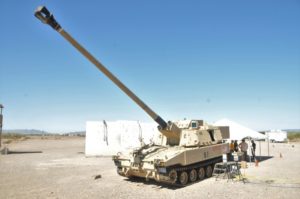A House Armed Services Committee panel is seeking information from the Army on plans to increase the rate of fire for its future Extended Range Cannon Artillery (ERCA) howitzer system, including the service’s pursuit of an autoloader or “alternative technologies.”
The HASC Tactical Air and Land Forces Subcommittee’s mark for the fiscal year 2022 National Defense Authorization Act, approved by the panel on Thursday, notes a test last year of the Army-designed autoloader “failed to demonstrate suitability” and the service should provide information on its assessment for identifying technologies to address rate of fire improvements.

“Nonetheless, the Army is committed to exploring other potential technical solutions that will improve ERCA’s rate of fire without undermining its operational reliability and supportability. The committee supports this approach,” the panel writes in its mark.
Brig. Gen. John Rafferty, director of the Army’s Long Range Precision Fires Cross Functional Team, has previously said the Army is taking an open approach to meeting the ERCA rate of fire requirement, considering two paths focused on continued work on a 23-round capacity autoloader along with the innovative ideas being developed out of a new small business cohort.
The first ERCA production systems , which involves putting a 58-caliber, 30-foot gun tube on BAE Systems’ M109A7 self-propelled howitzer chassis and is designed to hit targets out to 70 kilometers at a rate of six to 10 rounds per minute, will be fielded in 2025, while Rafferty has also that the Army’s initial goal to roll out the government-designed autoloader by 2024 “is not a viable option for us anymore.”
In April, the Army announced the five small businesses selected for the Fire Faster Cohort to refine concepts that could be applied to increasing the ERCA rate of fire, to include ideas for automating specific components within the ERCA cab from the handling of ammunition to loading fires (Defense Daily, April 16).
The panel’s mark directs the head of Army Futures Command to provide a report with detailed schedules and funding profiles for addressing ERCA rate of fire as well as information on similar technologies being developed for NATO allies’ artillery systems that could be applied to or inform development in this area.
The report should also identify the technologies the Army is currently considering and how it plans to ensure “the widest possible participation of relevant and available technologies in a free, fair, and open competition” for future development.